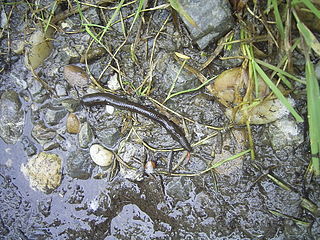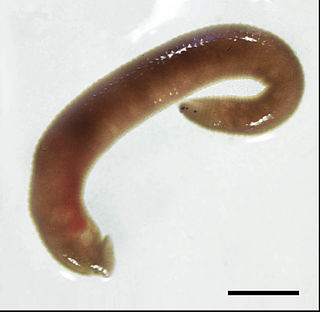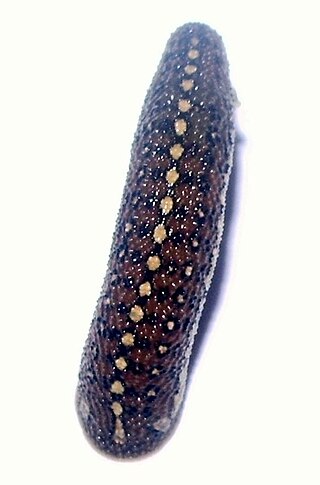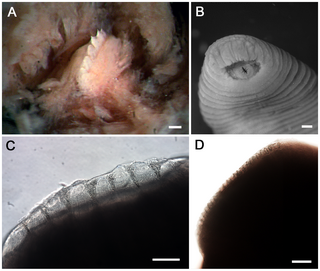
Rhynchobdellida, the jawless leeches or freshwater leeches, are an order of aquatic leeches. Despite the common name "freshwater leeches", species are found in both sea and fresh water. They are defined by the presence of a protrusible proboscis instead of jaws, and having colourless blood. They move by "inchworming" and are found worldwide. The order contains 110 species, divided into 41 genera and three families. Members of the order range widely in length, usually between 7 and 40 mm. They are hermaphrodite. The order is not monophyletic.

The Clitellata are a class of annelid worms, characterized by having a clitellum - the 'collar' that forms a reproductive cocoon during part of their life cycles. The clitellates comprise around 8,000 species. Unlike the class of Polychaeta, they do not have parapodia and their heads are less developed.

Pearson's horseshoe bat is a species of bat in the family Rhinolophidae. It is found in Bangladesh, Bhutan, China, India, Laos, Malaysia, Myanmar, Nepal, Thailand and Vietnam.

The least horseshoe bat is a species of bat in the family Rhinolophidae. It is found in Cambodia, China, India, Indonesia, Laos, Malaysia, Myanmar, Nepal, Thailand and Vietnam. It is a food source of the parasite Sinospelaeobdella, a jawed land leech.

The Chinese rufous horseshoe bat is a species of bat in the family Rhinolophidae. It is found in Bhutan, China, India, Nepal, and Vietnam.

Helobdella is a genus of leeches in the family Glossiphoniidae, the freshwater jawless leeches. They occur worldwide.

Arhynchobdellida, the proboscisless leeches, are a monophyletic order of leeches. They are defined by the lack of the protrusible proboscis that defines their sister taxon, the Rhynchobdellida. Arhynchobdellida is a diverse order, comprimising both aquatic and terrestrial, besides sanguivorous and predatory, leeches. The order is divided into two suborders, Erpobdelliformes and Hirudiniformes.

The Hirudiniformes are one of the currently-accepted suborders of the proboscisless leeches (Arhynchobdellida). Their best-known member is the European medical leech, Hirudo medicinalis, and indeed most of the blood-sucking "worms" as which leeches are generally perceived belong to this group. In general, though some leeches suck blood, many are predators which hunt small invertebrates.

Leeches are segmented parasitic or predatory worms that comprise the subclass Hirudinea within the phylum Annelida. They are closely related to the oligochaetes, which include the earthworm, and like them have soft, muscular segmented bodies that can lengthen and contract. Both groups are hermaphrodites and have a clitellum, but leeches typically differ from the oligochaetes in having suckers at both ends and in having ring markings that do not correspond with their internal segmentation. The body is muscular and relatively solid, and the coelom, the spacious body cavity found in other annelids, is reduced to small channels.

Xerobdellidae are a small family of jawed leeches in the order Arhynchobdellida. Xerobdellidae have three jaws and five pairs of eyes, the fourth and fifth being separated by one or two eyeless segments. The genera placed herein occur in Chile (Mesobdella), Europe (Xerobdella) and Diestecostoma is found in Central and northern South America. This peculiar distribution strongly suggests they are a relict Pangaean group, which had already been present by the start of the Jurassic 250 million years ago.

Phytobdella catenifera is a large terrestrial leech found in Peninsular Malaysia. John Percy Moore chose this species’ epithet ‘catenifera’ after the striking chain-striped pattern on the creature's back.

Adeleorina is a suborder of parasites in the phylum Apicomplexa.

Erpobdella is a genus of leeches in the family Erpobdellidae. Members of the genus have three or four pairs of eyes, but never have true jaws, and are typically 20–50 millimetres (0.8–2.0 in) long. All members do not feed on blood, but instead are predators of small aquatic invertebrates, which they often swallow whole.

Branchiobdellida is an order of freshwater leech-like clitellates that are obligate ectosymbionts or ectoparasites, mostly of astacoidean crayfish. They are found in the Northern Hemisphere and have a holarctic distribution in East Asia, the Euro-Mediterranean region and North and Central America, with the greatest species diversity being in North and Central America.

Hirudo is a genus of leeches of the family Hirudinidae. It was described by Carl Linnaeus in his landmark 1758 10th edition of Systema Naturae.

Erpobdellidae is a family of leeches. It is one of the four families belonging to the suborder Erpobdelliformes of the proboscisless leeches order, Arhynchobdellida.

The Piscicolidae are a family of jawless leeches in the order Rhynchobdellida that are parasitic on fish. They occur in both freshwater and seawater, have cylindrical bodies, and typically have a large, bell-shaped, anterior sucker with which they cling to their host. Some of the leeches in this family have external gills, outgrowths of the body wall projecting laterally, the only group of leeches to exchange gases in this way.

Praobdellidae is a family of hematophagous leeches which live on the mucous membranes of mammals and sometimes invertebrates. These are internal parasites that enter the body through natural orifices, and cause hirudiniases.
Sinospelaeobdella is a genus of jawed land leech, endemic to caves in China. It contains the species S. cavatuses and S. wulingensis, the latter being named after the Wuling Mountains where it was found.
Tritetrabdella is a genus of terrestrial hemataphagous leeches in the family Haemadipsidae. Unlike other haemadipsid leeches, Tritetrabdella species have four annuli on their mid-body segments. They have three jaws, with a total 45 teeth, and lack salivary papillae. Tritrabdella feeds primarily on amphibians and probably on small mammals as well, but to a lesser extent. Bornean species may be endangered due to amphibian population decline, disturbance and fragmentation of habitat, and climate fluctuations.


















